Saturday, April 4 (1998)
Morning: JM, Kyle, Swee Chiang, Sue Hixson, Joyce Fan, Mike Flecker, GGY
B3: spit one: many signs of recent soil admixture. Reddish soil color, iron axe head, roof tiles. East side of unit may not be as disturbed. It has been left in place while the fill from the south end is being removed. There is also an intact (?) section at the north end of the unit. Most artifacts are clustered at the northern and eastern ends of the unit.
C3: spit one: few signs of disturbance. Black sand. Shell (clams), small round features in SE quadrant.
Afternoon: Omar Chen, Rose. C3: Spit 1: continuation, similar to above.
B2 Spit 1
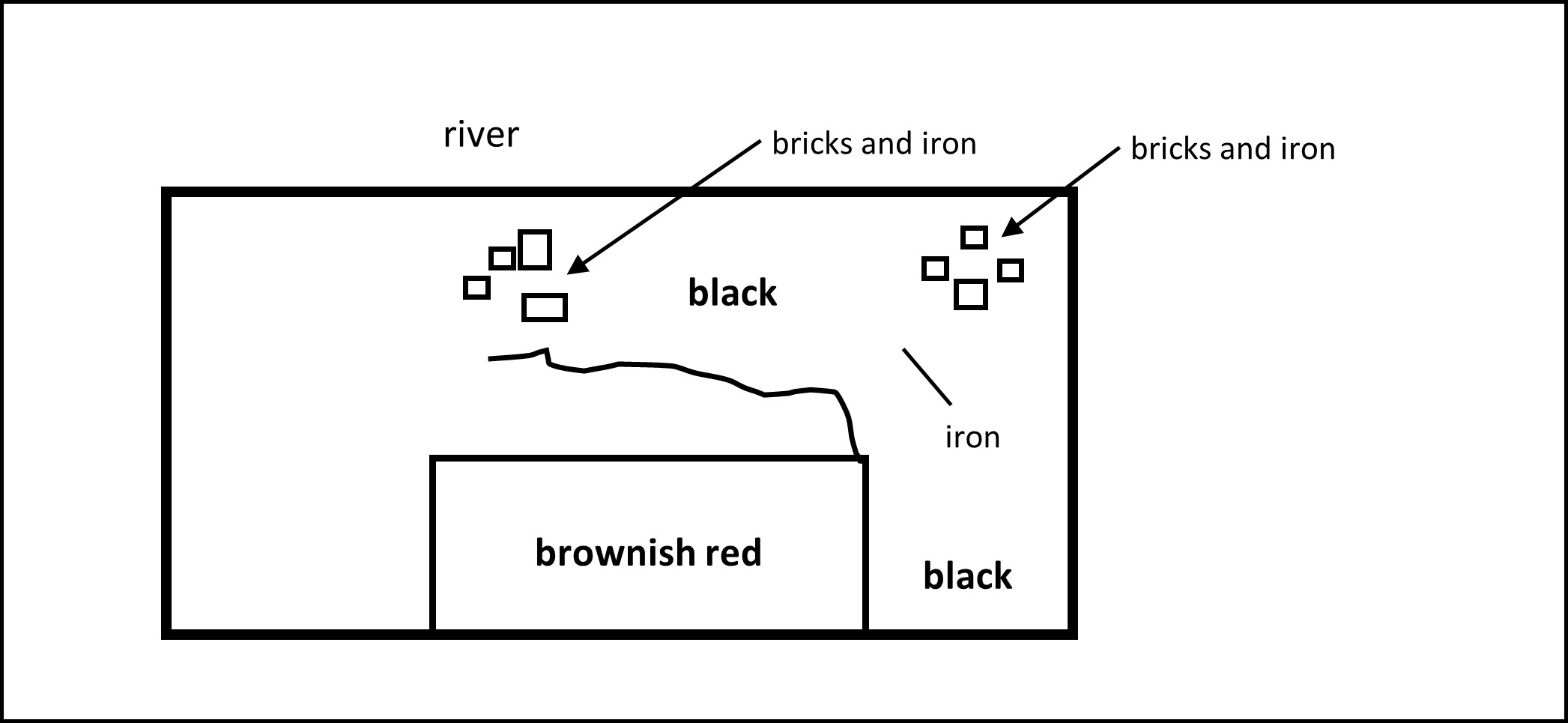
Sunday, April 5th
Mid-morning: Omar.
B2-Spit 1: 10 cm. Continuation from yesterday. Much the same – sherds from black portion.
Monday April 6: Kyle.
Cheryl came early. There were 6 volunteers. They continued with spit 1 in unit C3; spits 1 and 2 in unit C2 and spit 0 in unit B3. I arrived about mid-morning. Nothing particularly unusual, except some charcoal concentrations in unit C3 may deserve a closer inspection. Started raining about 11:30 on and off and then more heavily at 1:30.
Monday afternoon: Omar, Randie, Faizah.
(More expected.) Left gate key for John.
B2 – Fewer iron bits away from river. No coins here. Reddish/light brown.
C3 – VOC coins. Black soil.
B3 – Light brown to reddish dark soil. Chinese/VOC coins.
Tuesday April 7th: John N. Miksic
Morning ±10 volunteers.
Afternoon: 12 volunteers. Beautiful weather: sunny, breezy.
Picked up key. Met contractor, who promised to build a shelter soon. He asked that the gate be locked each night, except when his workers were still present.
B3: continued work in disturbed area (So) at southern, western sections.
C3: spit 1. Numerous small features: white round sand in black zone, especially southern half.
C2: removing spit 0.
F/G4: removed S0, began S1.
D3: intact wooden post in NW corner. To be left in situ, with ±8 cm of soil around it, to keep the wood protected. To be moved only after the bottom of the cultural layer is reached.
B3: Bagged the south end artifacts separately because they seemed to be very different from the obviously disturbed deposits in the center of the unit. The central area has been excavated as spit 0 since it is obviously disturbed. The cross-hatched area [in the sketch map] will be excavated down as spit 1 although it is over 20 cm in some areas. The south end will also be bagged separately. Later, when level, it [the whole unit] will be taken down as spit 2.
Wednesday, April 8th 1998
Heidi supervised the morning shift and Cheryl came mid-morning on. We all worked in B3 levelling it out. I’ve (not sure who wrote this) noted that all coins so far and most iron come from the upper to surface portions of the deposits. Also, faunal remains such as small fishbone, mammal bones, & smaller shells come from the upper portions of the deposits as well – almost entirely restricted to the surface/spit 0-1 transition zone. As expected, brick and tile pieces come from the upper portions as well. The lower portions yield a significantly greater amount of earthenware (often combed/incised), stoneware (many lugs/handles), celadons, & porcelains. The shell increases in size and number and completeness dramatically; however, limited to about 2 varieties of gastropods which dominate. Also, plenty of oyster shells (?)---maybe – need to verify. The amount of tile & brick decreases dramatically, but is still present at the base of the unit thus far. The disturbed central area, which is probably still spit 0, contains most of it. However, in the south side of the unit, a brick was uncovered at the base—with a ‘post-hole’ indicating it was likely dug into the deposit & placed there which may explain the presence of some of the 19th c stuff in the lower deposits.
Finished most of the unit down to what will begin spit 2. We found a ‘post-hole’ (Kathy did) which we covered with a brick-it’s also surrounded by a charcoal concentration which we pedestalled. Faizah almost finished the north end. Also, found two more areas which resembled the postmold described above, but tiles/brick chunks were at the base, and a black ‘mold’ was above the concentration. Omar showed up and we both finished the day.
9/4/98 Thursday
Have started in Spit 1 (10 cm down) on C2. Found wood on borderline of C2 and D2 and left a bucket upside down over it to keep damp. Have taken some samples to NHB conservation lab. 2 post holes also marked on C2 almost directly opposite the wood.
Heidi & Pamela H.
[Latinis]
Spent the day finishing spit 1 and the disturbed area in unit B-3. Also, finished about half of spit 2 on the east end of the unit. The disturbed area has a black thin band that almost looks like it may have been some kind of petroleum based lining at one time. Around it is sand fill. Within it is clay, bricks, tile, debris. It looks like it may have been an intrusive excavated pit for something – maybe not garbage—but something like an underground storage tank. We kept the artifacts (labelled under B-3 ½ disturbed central zone). I continued keeping the south end & north end artifacts separate.
-Moving from spit 1 to the base of spit 2 in the undisturbed areas, the density of artifacts and shells seems to decrease (but one must remember that spit 0and 1 were far deeper than 10 cm – but still, the artifact density seems to decrease). The base of spit 2 is still yielding artifacts. Almost all the ‘lower’ artifacts are celadons, stonewares and earthenwares. I only recovered one blue and white sherd, almost no metals (definitely no copper/bronze), no brick, no tiles, almost no faunal remains of animal or fish bones. The lower deposit is a consistent medium grained reddish brown sand – it seems to be fairly moist; almost no rock, but a few pieces here and there.
Also, at the south end, at the base of spit 2, we recovered 2 celadon plate bases with the raised fish motif. Additionally, Kathy recovered what looks like a glass/jade bangle fragment. Finally in the disturbed G.O.K./Schnirk zone (the central disturbed area we recovered a stone (?)/ceramic (?) donut looking thing with a flat end that may have been a sinker (?) or brader (?).
Omar and I bucked out much of the disturbed area so it won’t flood back into the ‘un-tainted’ area. Spit 3 will yield artifacts. The SE corner is already at the top of spit 3 (tell excavators to try not to dig too deep).
Did a little work in C3 spit 1 but got a little deep in a few spots. It’s beginning to seem somewhat consistent with the B3 ‘undisturbed’ deposits.
Aloha – see you in about 10-12 days. (DKA)
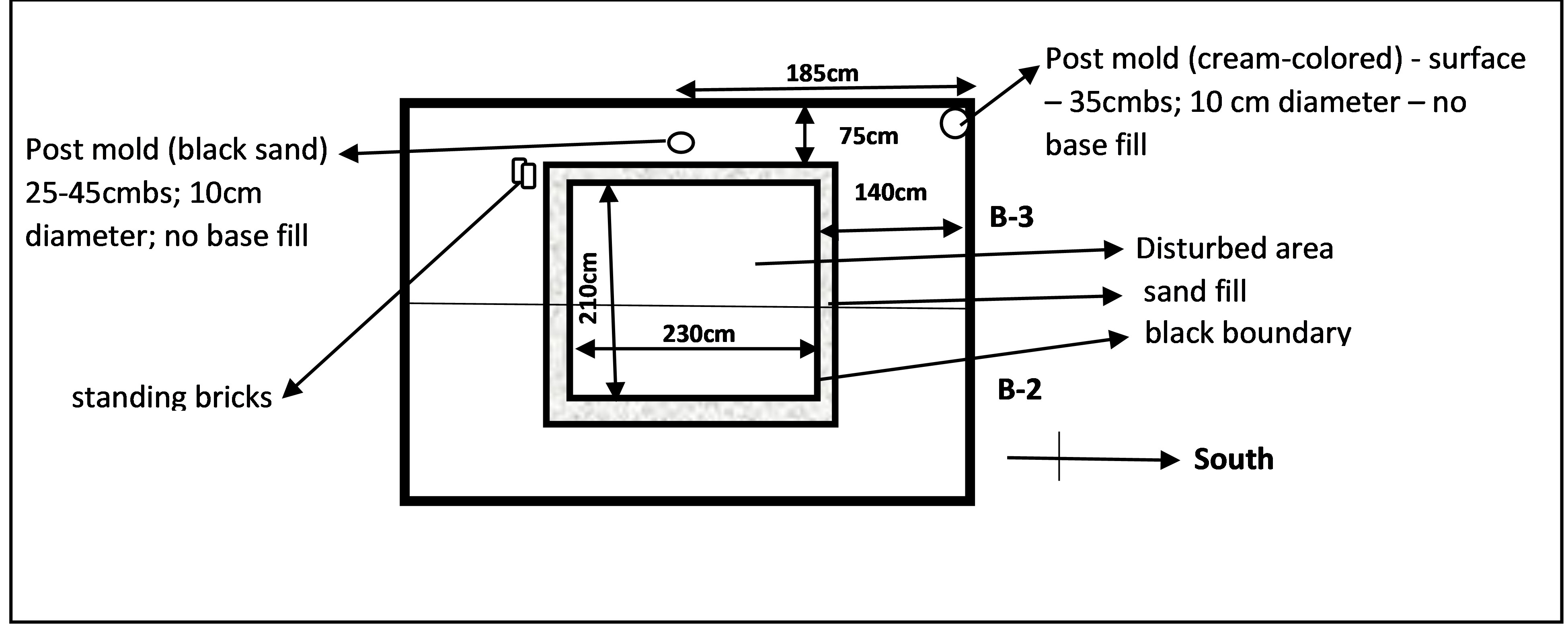
10 April JNM
Morning: good weather. 10 volunteers.
C3 spit 1: white sand features:
[in another hand:] Work on Sq F4 (spit 1 0-10 cm depth). Southern 1.7 metres not excavated because of its proximity to the stairway because it might lead to landslides. Spit 1 is black sand but some concentrations of brick and stone and glass – and recent pottery. The guates (?) of this concentration are not well-defined. Some concentration of iron and artifacts.
Sunday 11 April: Omar
Afternoon. C3 spit 2: carried on. Few shells. Few porcelain, more earthenware. Soil darkish brown. G.O.K. sq – Attained same level as yesterday’s piece of wood. Found more wood & water seeping into this – a lot of fresh-smelling mud. A pit full of wood bris? Most at water level. Yesterday’s piece of wood almost hidden in water.
13 April: Danny 9.50 am-1 pm
-3 volunteers working in Sqs D2/D3. Both sqs are still in spit 1
-3 “” in Sq E3 (new sq). #5 excavation still in spit 1.
Afternoon: Omar, Alison, Monica, Kathy, Bee Lim, Lim
E3 – spit 0. Equal amt of shell and artifact fragment
Spit 1: still similar qty of artifact and shell but with greater concentration of iron patches and pieces of wood or brick. Soil black.
D3 – Spit 1 – Iron patches, potsherds, shells, black soil.
G.O.K. – Rough sketch of decomposed wood in 2 layers. Gooey mud at bottom of 2nd layer with water seeping through. Very interesting. Very few artifacts, shells. Lots of iron.
C3 – Spit 2 – Dug rather deeply out of enthusiasm. Sandy brown. Rather little artifacts.
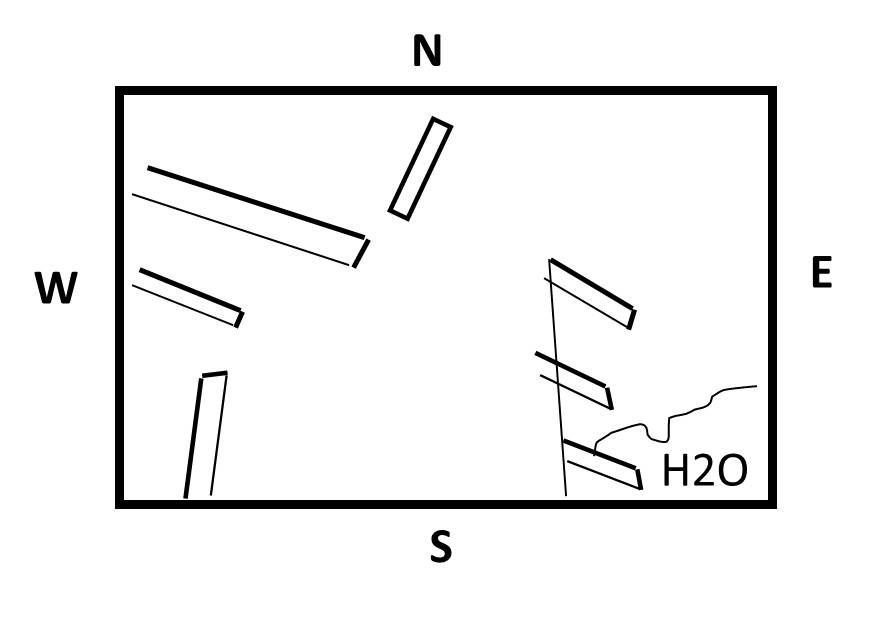
14 April 1998: [GGY]
Tuesday morning and afternoon: John, Geok, Omar, Bee Lim, Alison, etc.
F4 – Spit 2. A few (2 large) pieces of wood in black soil at W edge of sq. Lots of small wooden flakes, splinters one of about 40 cm long, very thin. Others are sticking out a E profile, looks like squaed off. Associated with 95% C14 artifacts. Some lighter colored wood below black layer.
GOK – worked on hacking out NE corner of GOK (thus spit 1-4 at B3). Lots of artifacts. Nice ones even. Very few shells. Bottommost layer an odd mixture of sand and very fine bits of shell. The top layer was of brown reddish sand. Exposed more of wooden structure going NE. Had to stop because of minor disaster – canopy set up by PWD couldn’t take weight of rain and folded. A rather wet day overall but things will look up at present system
JNM: (we hope!).
D2 – worked on layer of dense wooden artifacts until it flooded. Work has to be suspended in D2 for a few days until it dries.
E3: begun. West part: finished S0; east part still needs work.
F4: flooded, work suspended.
F3: drain dug through center; pieces of large wooden planks or boards discovered. This square is promising, but must be worked very carefully.
Suggestions for 15 April:
Work in C2, C3, D3: these are the driest areas.
C3: start in spit one, NE corner
D3: start on spit one, NE corner.
15 April 98 [GGY]
AM Cheryl, Laura, Mary, Bee, Jake, Connie
PM: Omar, Cheryl, Bee, Jake etc.
D3: near the edge on the side close to C3 [sketch map]
Spit 2: several bits of glass found and modern-day bottle
-2 pieces of glass
-tooth found (separate bag)
-little wood; iron stains aplenty. Black soil.
E3: concentration of charcoal at side close to D3 kept in a separate bag
Spit 2: lots of shells and wood. Black soil.
C3: some artifacts, shells. NO wood. Yellow brown sand with gray (mud?) discolorations at NW corner.
GOK: almost no work done here as I was attending to the propping up at the canopy.
Another canopy was put up at the western section at the site.
D3: a brown glaze [?] with black inscription, cracked. Left in situ to photograph the next day.
16 4 98 Thursday (Danny)
7 people working on site in total. 5 are working in Sqs D2/D3; 2 are working in Sq E3.
The area in Sq E3 (closest to Sq D3is very dark soil.
-Thought that it’s a refuse pit but not much artefacts/also complete shells found.
-Compared to other sqs, the shells in E3 are much bigger and much more concentrated. Also a lot of wood. Soil is also a lot darker and smellier. Can assume it’s some sort of food- refuse pit??
-also found a tusk (~20 cm long) in E3. NO other bones are found.
Thurs 16 4 98 Afternoon (Danny)
3 people working in total
1 is in Sq D3
2 is in Sq E3
In Sq E3, the area closest to Sq D3, down to spit 3 and still more wood and large clam-shells. The wood pieces are thin, long and lie in horizontal positions (i.e. no posts). Many bits of ceramics are associated with the wood.
Friday, 17/4/98 [JNM]
Morning: heavy rain, 10:00-10:30, but the roof held!
B3: one worker, NW corner. Brown sand, S3. No disturbance; few artifacts, but large: Ming BW, Yuan celadon.
C3: 4 workers, N & W. 2; S3: black sand, “Dutch” coins (small, thick, bronze, no hole), one Chinese coin. At this depth, the brown sand occupies the south half of the square. The north side is still S2; black silty sand. It appears that beneath the black sand, the orange/brown sand is gradually emerging.
D3: south: southernmost one meter is at middle of S3. Julia Oh working on the second meter, S1 and S2. Northeast corner: two workers, straightening east profile, in S1 and S2.
E3: north and south ends are deep, at top of S2. Middle part now being worked: S1. Two workers.
Suggestions for afternoon – Heidi:
Higher areas of D3, E3, which are still S1, get first priority. Then follow the line of division between the brown and black soil. We should bag the artifacts from brown/orange separately from the black, even if they are the same spit.
Friday pm continued as suggested above in D3 and E3. Uncertain above D3 S3 as marked by Danny. Could be S2? (Topsoil goes down deep to darker layer, which then measure 30 cm to Danny’s S3). D3 S1 and S2 still to be dug to level out the whole unit. Found a post or large mound of wood.
-Continued to take off the top layer in E3 and extended the S3 section. Found another 2 posts.
-Found a shaped flint in D3 S0 which looks like this
-5 of us on site.
18 04 98 Saturday am Cheryl
E3 Four volunteers. Some areas gone into spit 2. Volunteers today are levelling out from the spit 1 area. A lot of wood and charcoal (fairly large pieces) alongside close to D3 at E2 (and spit 1).
Wood quite tightly packed. Asked Connie to leave it and work at Spit 1 at the other end.
GOK: a big chunk of (?) at the side close to E2 and E3. I put a plastic bucket over it with note “(?)” on top.
D3: 3 volunteers. Not too sure about the spit levels and where the square ends on the northern end. I think the recently levelled Spit 1 on the northern end is Friday AM’s spit 1. Using width of E3 as a standard (220 cm), measured a width of 220 cm at D3 and anchored orange line across at northern line almost all arrived at Spit 3, but needs a bit of levelling out along the northern edge.
D2 2 volunteers. Started on spit 1 – D2 Spit 1 is lower than D3. Spit 0 & 1 (culture level one is a slope, I guess.)
E2: 3 volunteers. Started on Spit D 1. 1.20pm: have to leave; left instructions with volunteers (2 of them) about taking the equipment if they leave before 2 pm.
Saturday afternoon: Omar, Debbie, Angela, Larry (?)
F3: Spit 0. Very few artifacts and shells. Reason could be nearer to disturbed portion of site is parallel to river. Some glass, no iron.
C3: Spit 3. Some iron, artifacts, shells from shifting.
C2: Spit 2. No iron, few shells. Some artifacts.
GOK: More wood found that continues into C3.
Sunday 19.4.98. Morning: John & Co. Afternoon: Omar.
C2 Spit 1: Dark gray colored and giving way to orange brown at Spit 2 Few shells. Stopped work due to rain.
GOK: more wood found continuing into C2.
Tun Aye came and said he would look into canopy problem. Fortuitous, because after he left canopy at NE site collapsed due to heavy rain and weak prop. Bummer!
Monday 20/4/98 Danny
5 volunteers in all, all working in Sq E3. Trying to level E3 to the existing lowet levels. Part of roof covering collapsed. Propped it up temporarily. Sq D2/D3 flooded and water has not drained.
Tun Aye came this morning with contractor. He said in next 2-3 days he’ll build a more substantial roof, with water running off, not into the site but out on the top.
Afternoon: Omar. 8 volunteers. Water not drained by afternoon.
E3 Spit 4: Lots of wood, sherds. Less metal and shells. Black soil.
E3 spit 1: wood, sherds (19th century). Shells, no metal. Black soil.
C2 Spit 1: Sherds, shell, no wood or metal.
GOK: Even more wood! A square structure is beginning to emerge. Mud at the bottom. Lots of water seeping through.
Can’t complain about the breeze though it was just a bit much for the canopy to take at first.
21/4/98
JNM morning, afternoon.
C2: worked along east edge, parallel to C3. Followed boundary of interface between black silty sand on north, orange sand on south. Very irregular pattern, no clear level. Further north, about 15 meters from north end of square, interface could not be followed. Levelling off at -20 cm.
C3: north end: 75 cm form N to N end, did spit 3. Still all black.
D3: north end: began spit 4. Four wooden posts in NE corner.
E3: exposed woody mass at west profile; photographed. Two wooden posts adjacent to two bamboo (?) cylinders inserted vertically in soil. North end: much woodn, large shells.
F3: spit 2 more or less completed.
April 22nd: JNM morning and afternoon
Good weather, some thunder, a few sprinkles. Dug ditch along south and west sides for drainage.
F3: making trench, E-W, in spit 1-2 for drain.
E3: leaving wood in W for display, levelling to sit ¾ on east.
C2: continued exploring orange/black interface.
A2-A3: while making drain, discovered intact 14-15 century deposits – fine sand. Partially excavated, should be continued. Has 14c glass!
23/4/98: Thursday morning (Danny)
4 volunteers, all working in square E3.
A bamboo [probably nibong] posthole found in eastern half of E3. It has a small wooden stump wedged beside it.
Contractors are working on the western end of the site, trying to build the roof structure. They have put one steel beam across the entire width of the site. The guy in charge said that they would complete the job by the end of the week.
Afternoon (Omar) and 5 volunteers.
E3: black soil. Wood, sooo much wood! Coins, glass, stoneware, coconut husks, shells. Interesting sherds.
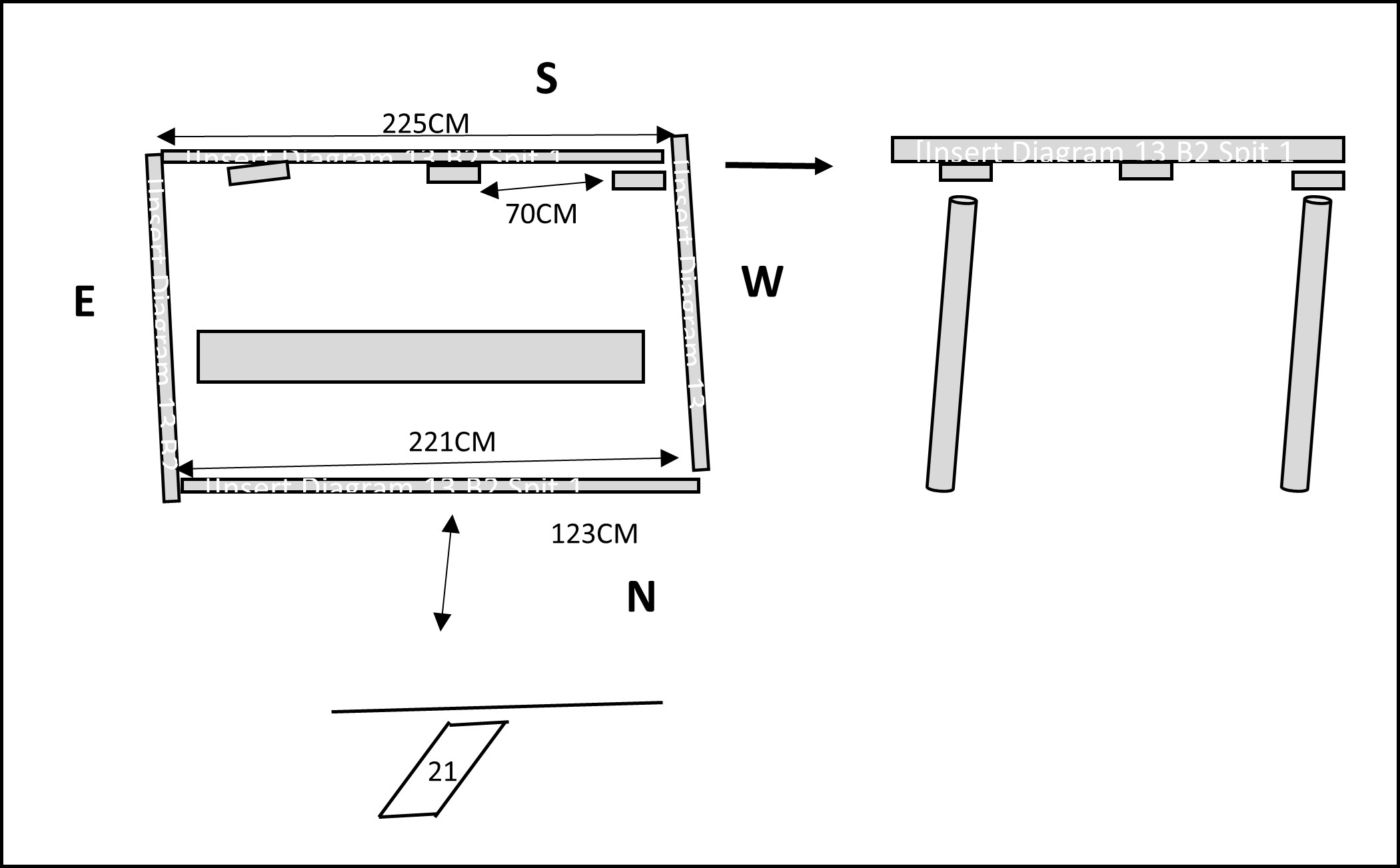
24/4/98: Friday morning: Danny.
10 volunteers in total, not including self.
2 in D3
4 in E3
4 in F3
No new depths were dug. All removed to reach the lowest existing levels. Lots of shells, wood, ceramics. Two reporters from the Singapore American newspaper came to do interview and photos. No work was done today by the contractors for the roof structure.
25 April 98: Saturday. 0 am-1 pm: Cheryl.
Logistics: contractor put up metal beams for a shelter. One of the beams BROKE!!!
D3: 4 volunteers. Found what looks like an antler near south end
A mound (GOK) with ceramics stuck inside. Ceramics left inside the mound except for one piece which came out and was bagged separately. Put bucket over the mound.
C2: 2 volunteers. Trying to level all with a trench.
D3: 2 volunteers clearing mud from wooden structure.
12 noon-2 pm: work to stop; contractors putting up metal beams - need Sat and Sun. to make sure everything at site is safe. If all goes well, we can safely start on Monday.
27/4/98 Monday morning (Danny)
4 volunteers: 2 in D3, 1 in E3, 1 in F3 – try8ing to level out the bumps and keep the site flat.
John & Tun Aye here to inspect the new roof.
[Note: Omar, can you please fill up the form and then pass/fax it to Heidi Tan? Thanks.]
Afternoon: John, Kyle, Omar, 9 volunteers.
B3 Spit 2: Found kendi base, 13-14 centuries, at edge at GOK. Some 14c sherds. Nil shells. Some iron. Yellow, orange sand except at edge of GOK.
Pictures taken of mottling in center of unit.
Note: try to keep people from digging potholes and deep pits.
Cleaned out the center section and bagged artifacts separately as spit 4. Then worked on oly leveling the dark deposit as spit 5. This area is definitional a transition area between the reddish sand and the black-gray loamy sand. The reddish sand will be excavated as Layer II separately. The dark area/deposit near the steps should be continued for another 5 cm as spit 5. If there are any questions on the stratification, ask John or Kyle and don’t excavate further.
Spit 5: 40-50 cm below surface near steps.
28 April 1998:
Omar continued levelling spit 2 in the west side of unit B3 while continued levelling spit 2 in the east side of B3. Karen sifted the slumped section and we labelled it separately as ‘clean-up above B3”. B3 is ready or close to it to begin spit 3. Karen had some intermixing as the disturbed deposits ner the features yielded more recent materials.
Finished spit 5 (Layer I - the dark blackish loamy sand) in unit C3. Began spit 6. The mottling slopes downward to the stairs as expected and likely represents the transition between the two lower layers. Also, there’s a wooden post (tapered at the top) emerging!
Two volunteers on unit D2, spit 2 doing good work on levelling it out. I had them remove the wood and stack it behind the unit. There’s been a fair amount collected (4 buckets); mostly flat cut pieces (less than 3 cm thick and 6 cm wide – varying lengths), and some round ieces (mostly less than 5 cm diameter).
Removed much of spit 0 (sand overburden)) in E2.
Mei Li removed the pedestalled area (spit 1 and 2) in E3. There was not that much wood removed, but a considerable concentration of shells. There were also plenty of coconut shell and other seed/nut remains. The shells were large.
A well-preserved Chinese coin was also recovered, also a stoneware jar, “dragon” applique sherd.
Earlier, a lot of wood was recovered; big pieces (some 10-15 cm diameter).
Also, some rope/cord has been exposed in the profile.
Several ceramic “tokens” also recovered today.
29 April 1998: Cheryl.
AM: D3: 1 volunteer levelled wall between D2 and D3. The square is now spit 3 (at lower end of slope towards D2. Spit 4 at the higher end towards D4.
AM: D2: 1 volunteer. Ceramics, very dark soil.
AM: D2: 2 volunteers lots of wood
AM: C2: 4 volunteers. Ceramics and lots of iron rust. (lower soil)
PM: C2: 2 volunteers – side close to B2 reaching Spit 2 way before the area further down – brown soil on side closer to B2 is higher.
B2 and B3: 3 volunteers (Kate, Aliwayah and Irving) Layer 1: 14C layer.
April 30: John, Cheryl, Omar, Debbie-Ann, Su-lin, etc.
B3 spit 2 (completed): no shells, few artifacts, mostly stoneware. Orange-yellow sand. No wood.
Spit 3: few shells, some artifacts, sandy soil. No wood.
C2: Black soil with interesting finds eg. ½ figurine (Yuan). Few shells, few artifacts. No wood.
F3: Black soil with wood finds. 14C finds?
May 1, 1998
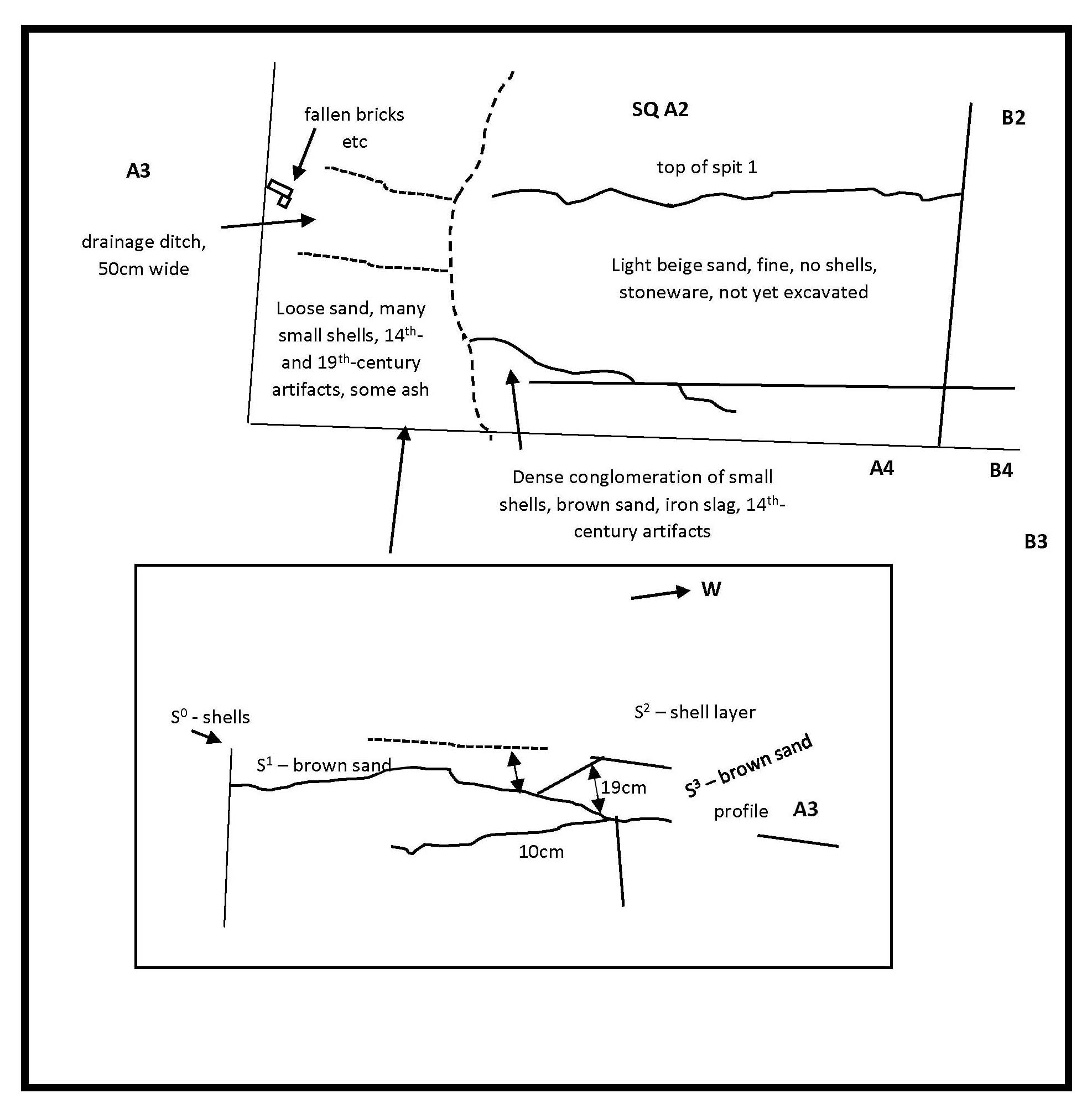
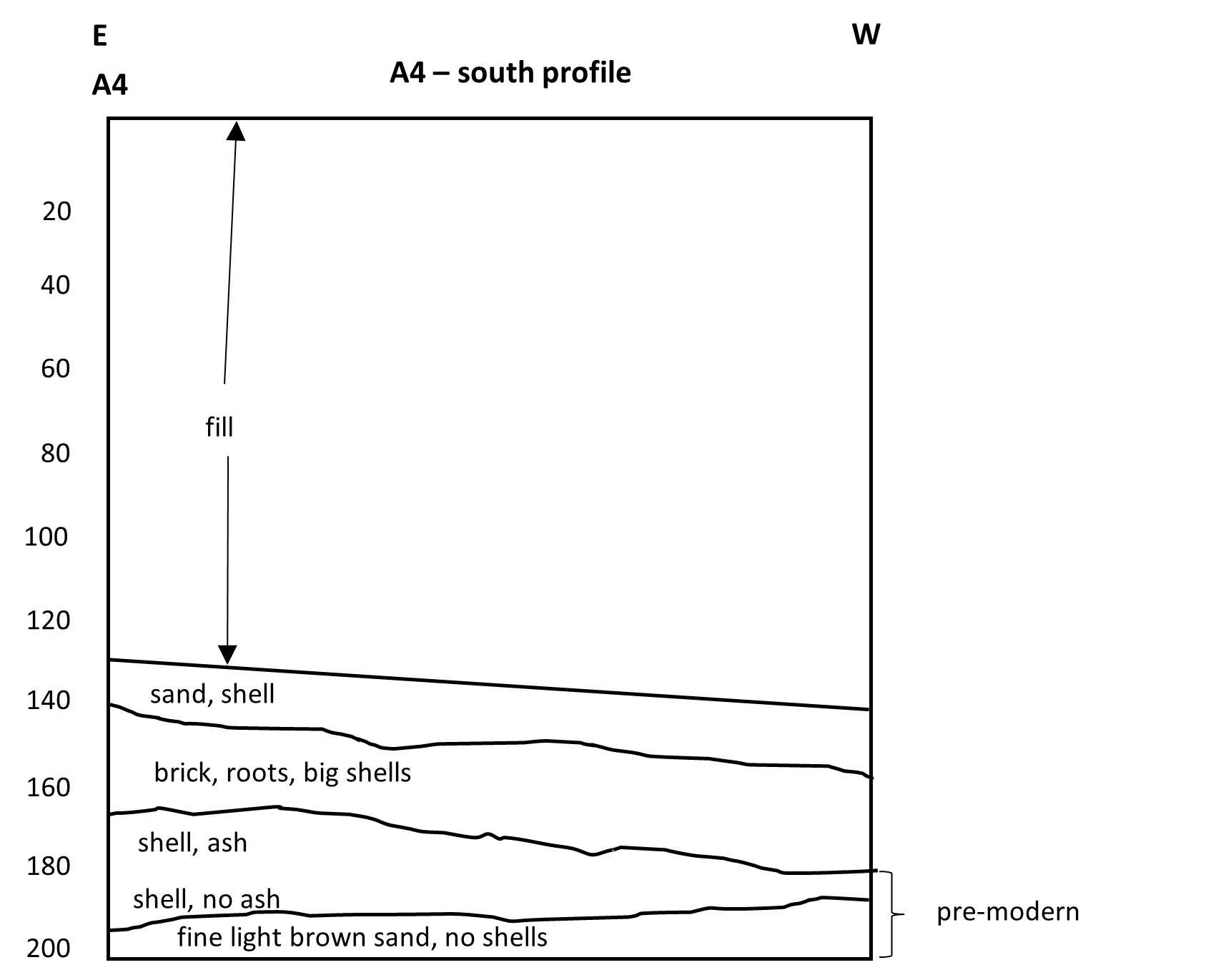
May 2 (Saturday morning). Danny.
3 people working on site. Rained heavily at 1030 am. Roof held up but had to push away water that accumulated on the plastic sheets.
Architect Kok Meng came and told John that the digging may be extended to end-May, approval pending.
John said for the most inexperienced volunteers, they can work in the dark soil areas (e.g. dig out the wood). For the more experienced, they can work in the transitional (i.e. where orange soil meets black).
Afternoon: Omar
It rained heavily and had to push the water off the canopy, a wate of time!
F3: spit 1 (end portion going west). Mostly 19C stuff – wood, shell, black soil area.
F2 spit 1: same.
C3: Orange sand, most 19C stuff though some iffy.
4 May
AM: Dr. Miksic and 2 volunteers. PM: Cheryl and 3 volunteers.
B2: orange layer: layer 2/sit 2: ceramics.
C2: still trying to get rid of bottom layer of black soil; spit 2. Starting to encounter some wood pieces. As this square is generally wood-scarce, I saved them. Fewer ceramics than before.
D2 (spit 1) Found in GOK resembles a very hard seed, bagged separately. Several found previously in F. Big piece of wood: Bee Leng working around them, clearing the soil from the wood.
Suggest: E2: carry on clearing soil off the wood. Leave the big pieces of wood in situ. Remove the small chips.
C2: peel black layer to revel orange soi but be careful cos we getting in the orange layer (14c) already. Put experienced diggers there.
B2 at the edge: found a set of teeth with jawbone near huge fragment of a plate (bagged separately).
5 May 98 Tuesday: Morning (Omar). What quiet day! (3 volunteers)
Northern portion: C2 spit 3: orange, yellow sand stops about ___Cm towards western portion at D2. Few artifacts I former type sand and heaps of stuff mostly 19C in black soil with wood. Nil shells.
C3 spit 3: orange, yellow sand with few artifacts. No shells.
G2 Spit 0: 19C stuff, some wood, no shell.
G3 spit 0: similar to G2, coal, wood, no shell.
Checked jawbone found at B2, possibly pig due to 4 incisors enlarged and raised front incisor, close-set lophodont bottom molars with one at posterior embedded points to juvenile. Right jaw. Should point to one individual if the other jaw that I found, also in B2, is similar to teeth characteristic with jaw measurement. C19 layer I think.
5 May 98: Tuesday afternoon (Danny)
No volunteers. I’m going back now (2.15 pm) to attend to urgent work. I’ve left a note for volunteers.
7 May 98: Thurs morning: Omar, 3 vols.
Yet another quiet morning until a storm broke. The structure held thankfully.
C3 spit 3: last 60 cm of this square has black soil. Starting to get wooden posts but debris like E2. Lucky as this would really be a pain in the neck (literally). Shell bits, 19C sherds, building material, tiny bits of wood.
D3 Spit 3: Similar to above. Just starting to get in.
E2 spit 1: Lot of complain from many people about digging amongst wood debris. Mostly 19C stuff though some quite interesting sherds with black glaze and human motifs. Bits of glass here and there. Black soil.
G3 spit 0; Lots of junk, building stuff. Ready to start spit 1.
7 May 1998 Heidi.
Maureen: some large piece of kitchen Qing. Working on E2 with Pon and Karen. Working around the wood. Photos to be taken of wood layer?
Susannah taking down S2 in E3. Found interesting glass globule.
Heather working on G3. Mainly shell, some kitchen Qing, celadon and grey stoneware.
Heidi and Heather worked on C2S3 – mostly earthenware, few celadon in orange sand, grey and green-glazed stoneware mostly on darker soil towards unit D
8 May: A3
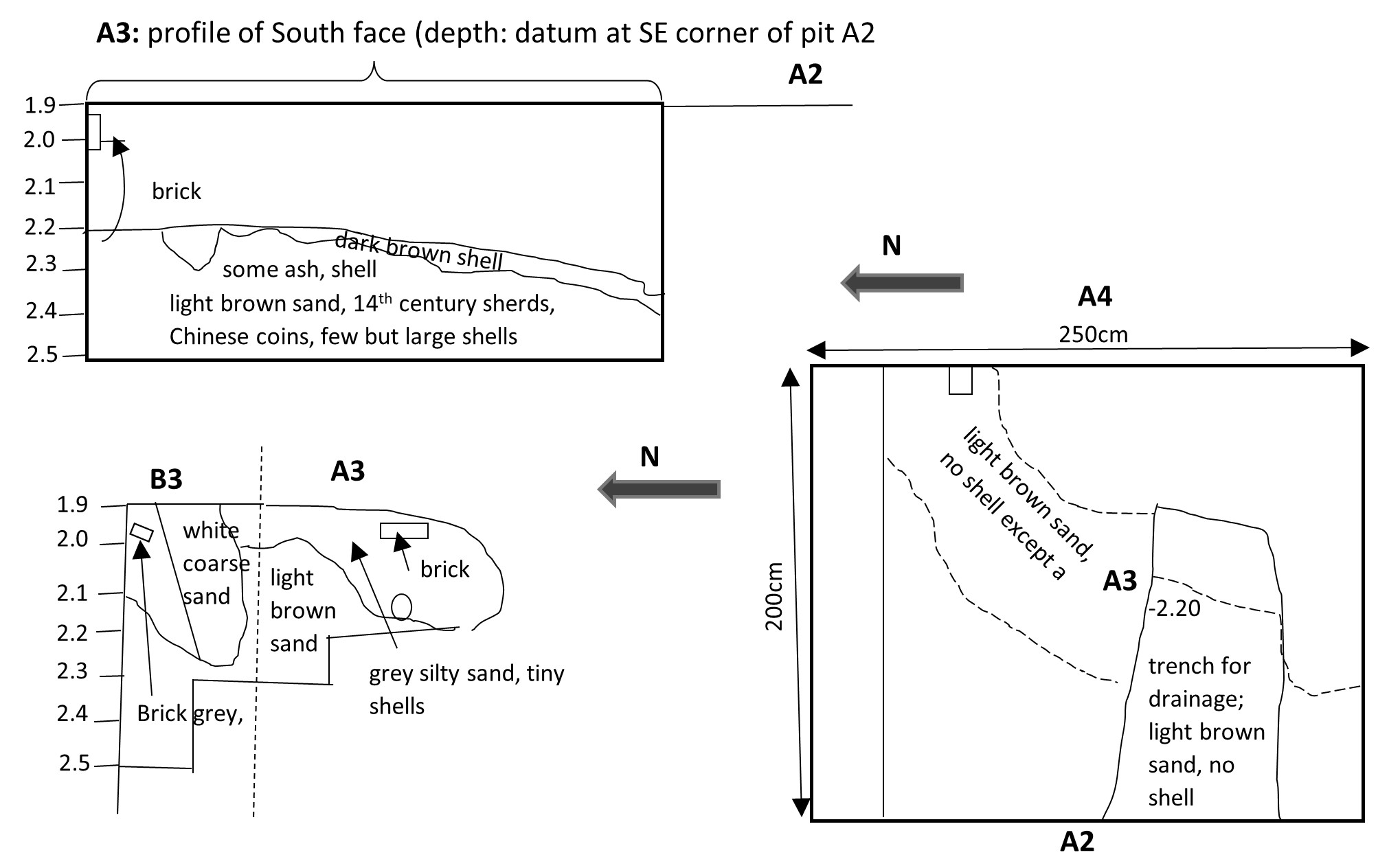
May 9: early AM heavy rain caused complete collapse of plastic sheets, fracture of a steel beam in H3, site flooded 30-40 cm deep. Pumped water out. Volunteer workers suspended. Rest of excavation by JNM, GGY.
May 10:
repaired plastic sheets. Steel beam replaced.
May 11:
Vesak day. Worked in A3-A4, B2-C2
May 12:
Heavy rain in afternoon. Site again flooded. Beam in H3 cracked.
May 13:
Worked on B4, removing soil from eroded face of B4.
May 14:
Omar at site. Workmen put wooden blocks under beams in south end of site.
May 15:
Heavy rain last night. No beams broken, but site again flooded. Only area not submerged: A1-A5, B1-B2, part of B3, B4-B5, C4-C5, D4-D5, to end of pit.
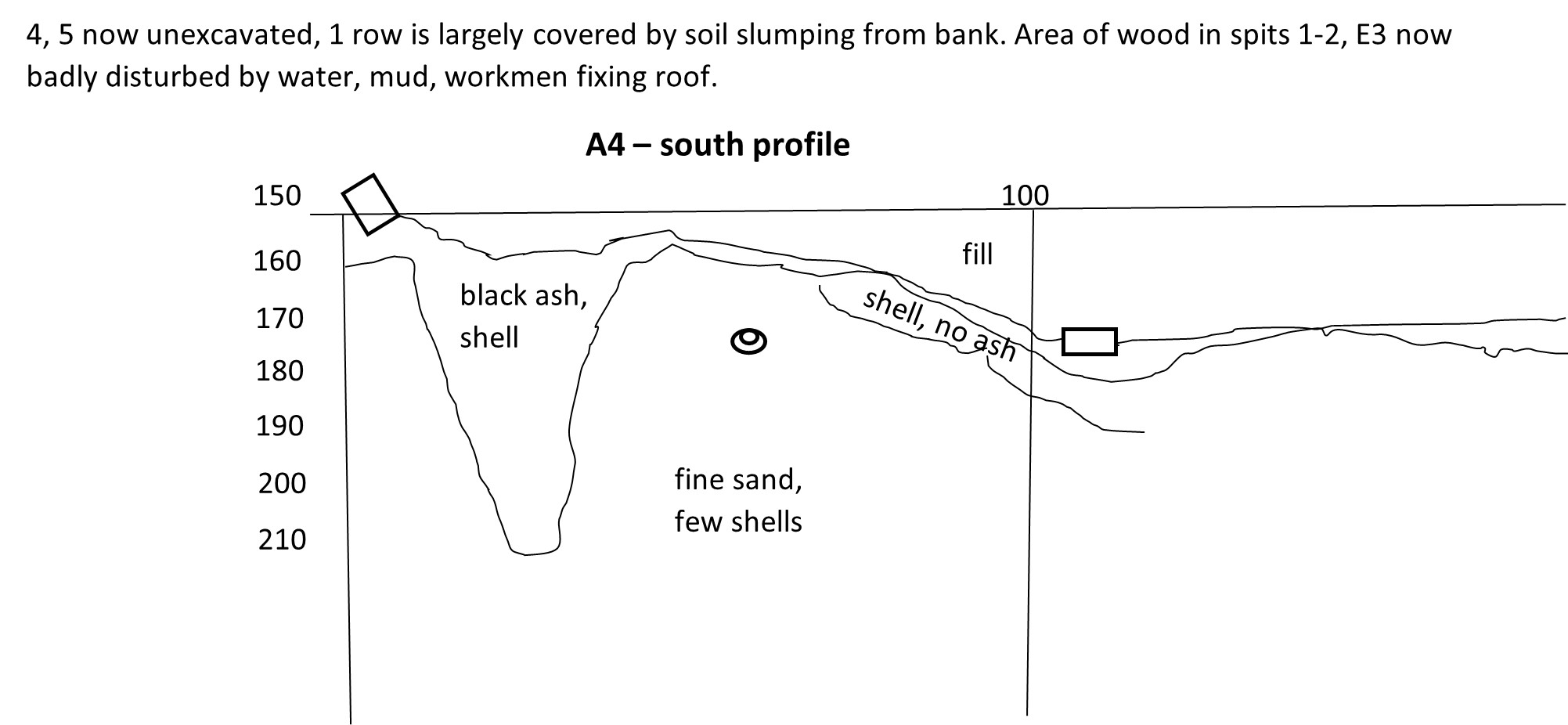
May 16:
A3, A4 – second shell layer, S3. Some features: dark loam, some small roots.
May 17-19:
A1 by myself.
May 21:
A1: continuing gravelly spit beneath intermittent shell layer: S3. Good weather for past several days. Orange sand: 7.5 YR, 4/4
May 22:
finished A1
May 23:
no work.
May 24:
Major storm, flooding. Began A2 spit 3.
A2 spit 4: sparse finds. Several associated with round postmolds 10 cm in diameter.
One on east boundary (with A3), 50 cm from north.
Another 70 cm from East, 240 cm from north
Another on west border with A1, 240 cm from north. Length of A (N-S): only 3 m.
June 4th:
A3: working in spit 7, which is 30 cm thick. Almost sterile.
June 6-7:
A worker helped carry dirt. Excavated C3 to 1+ meter beneath top of spit 1. Earlier boundary between orange sand and black mud now appears to show extent of a sandy lens projecting north. In middle of C2-C3, the black mud continues straight down. Many deposits, almost forming a continuous layer, of shell grit appear. Afternoon, evening of June 7: continuous heavy rain. Next morning, site flooded from B2/B3 to C2/C3, E2-E3 just above water; almost exactly same level as bottom of excavation in A2/A3.
June 8:
Vonya, occasional man helper. C4 spit 1: black silt.
B4: north end: down to bottom of spit 4, 55 cm beneath surface. At this depth soil changes from orange sand to pale sand.